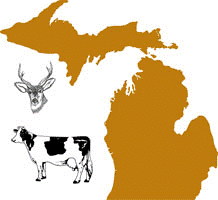Wildlife Disease and Zoonotics
Date of this Version
1997
Abstract
A 4.5 yr-old male white-tailed deer (Odocoileus virginianus) killed by a hunter during the 1994 firearm hunting season in northeastern Michigan (USA) had lesions suggestive of tuberculosis and was positive on culture for Mycobacterium bovis the causative agent for bovine tuberculosis. Subsequently, a survey of 354 hunter-harvested white-tailed deer for tuberculosis was conducted in this area from 15 November 1995 through 5 January 1996. Heads and/or lungs from deer were examined grossly and microscopically for lesions suggestive of bovine tuberculosis. Gross lesions suggestive of tuberculosis were seen in 15 deer. Tissues from 16 deer had acid-fast bacilli on histological examination and in 12 cases mycobacterial isolates from lymph nodes and/or lungs were identified as M. bovis. In addition, lymph nodes from 12 deer (11 females and 1 male) without gross or microscopic lesions were pooled into 1 sample from which M. bovis was cultured. Although more male (9) than female (3) deer had bovine tuberculosis infections, this difference was not statistically significant. Mycobacterium bovis culture positive deer ranged in age from 1.5 to 5.5 yr with a mean of 2.7 yr (median 2.5 yr) for males and 3.2 yr (median 3.5 yr) for females. This appears to be the first epidemic occurrence of M. bovis in free-ranging cervids in North America. A combination of environmental (high deer density and poor quality habit) and management-related factors (extensive supplemental feeding) may be responsible for this epizootic.


Comments
Published in Journal of Wildlife Diseases.